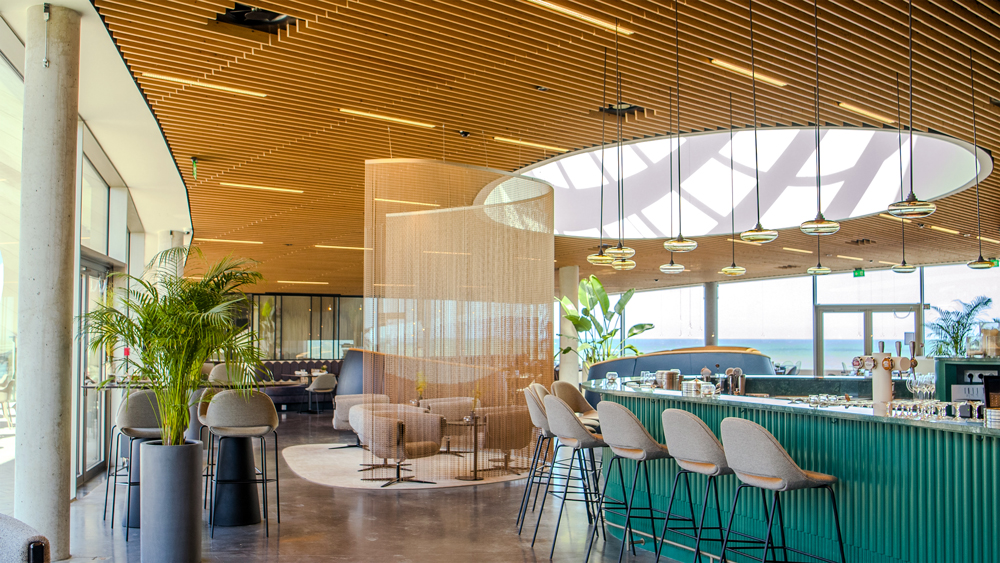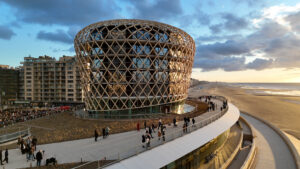
A dazzling new landmark has landed on the Belgian coastline which is ‘setting the standards’ in how to design, build, and protect cities from rising seas.
Nestled in the dunes of Middelkerke, the stunning SILT complex has been described as looking like a ‘giant sculpture from the future’. The building is part casino, part hotel, part event space – and all smart.
Covering an area the size of eight football pitches, the SILT is a 1,500 m² multi-use venue including luxury hotel rooms, a Michelin-starred restaurant, and even a huge underground car park. But the twist is it is all wrapped in a sleek, futuristic shell inspired by a ship’s bollard which blends seamlessly into the man-made dunes that shield the town from the sea.
Built to withstand a once-in-a-millennium storm, SILT, is said to be ‘more than a playground for the rich’ but a model for how coastal towns can future-proof themselves without sacrificing luxury or style. Designed by a collaboration of top-tier architectural and engineering teams, the whole building is a ‘masterclass in design without compromise, proving that being green doesn’t mean going without’.
Hidden inside this architectural wonder is a high-tech control KNX system powered by B.E.G. – the German lighting controls manufacturer which produces some of the smartest sensors on the market. The Municipality of Middelkerke, the local government, commissioned the project as a flagship for coastal renewal, public utility, and tourism.
The KNX system is a globally recognised standard protocol for home automation and building automation which connects and controls lighting, heating, ventilation, security and blinds via a single network. As a result, these devices work together seamlessly in the SILT complex and offer optimum energy efficiency, convenience and flexibility in the management and automation of functions in the building.
Paul Jones, Sales Director of UK & Ireland at B.E.G., said: “In a world where energy efficiency and sustainability are paramount, occupancy sensors are no longer a luxury but a necessity. This advanced solution is an important contribution to the SILT project. The use of sensors makes it possible to switch lighting and other technical systems on and off automatically depending on the presence of people, resulting in significant energy savings and lower operating costs.

By choosing KNX sensors, the project was able to fulfil all requirements in terms of flexibility, reliable detection and simplified installation set out by the Municipality of Middelkerke. The detectors offer an efficient solution for presence-based lighting control and at the same time contribute to energy savings by enabling demand-based control of lighting, heating and ventilation.”
For architects, one of the most important considerations in any project is to allow ‘freedom of design’ without being restricted by technology. B.E.G.’s ultra-slim sensors are “designed to disappear” and are so discreet that visitors will barely notice them according to Paul Jones, making it a perfect solution for SILT.
The optional remote control or B.E.G. One App can be used to activate numerous functions on the master device. Values such as the switch-on brightness and follow-up time can be changed easily and functions such as party switching can be activated simply and conveniently. The detection area can be extended by connecting PD11 slave detectors in the same discrete design.
Paul Jones said: “The SILT project represents everything we believe the future of architecture should be: sustainable, intelligent, and seamlessly integrated. It’s a visually stunning development that had extremely high demands when it came to both aesthetics and performance – and that’s where our KNX occupancy detectors really made a difference.
From day one, the goal for B.E.G. was to deliver a solution that supported the architects’ creative vision without compromising on energy efficiency, comfort, or safety. We’re proud that the B.E.G technology is now part of an iconic coastal landmark that not only looks extraordinary but operates smartly behind the scenes. SILT shows how intelligent building systems can enhance the visitor experience while dramatically reducing energy use – and that’s a win for everyone.”
SILT recently bagged the prestigious Chicago Athenaeum architecture award and Paul Jones says it is easy to see why: “It’s bold. It’s beautiful. It’s built to last. SILT is proof that the future of architecture is smart, sleek – and very, very stylish.”














